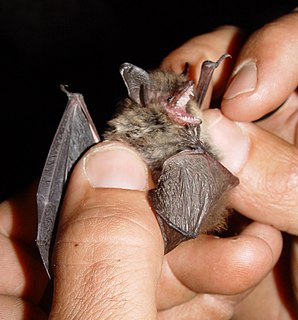
Vespertilionidae is a family of microbats, of the order Chiroptera, flying, insect-eating mammals variously described as the common, vesper, or simple nosed bats. The vespertilionid family is the most diverse and widely distributed of bat families, specialised in many forms to occupy a range of habitats and ecological circumstances, and it is frequently observed or the subject of research. The facial features of the species are often simple, as they mainly rely on vocally emitted echolocation. The tails of the species are enclosed by the lower flight membranes between the legs. Over 300 species are distributed all over the world, on every continent except Antarctica. It owes its name to the genus Vespertilio, which takes its name from a word for bat, vespertilio, derived from the Latin term vesper meaning 'evening'; they are termed as evening bats and once referred to as 'evening birds'.

The mouse-eared bats are a diverse and widespread genus (Myotis) of bats within the family Vespertilionidae.

The great evening bat is the largest bat in the vesper bat family (Vespertilionidae) and the only living species in the genus Ia. It is common to Eastern and Southeastern Asia, mainly living in areas with limestone caves at altitudes of 400–1,700 metres (0.25–1.06 mi). Their roost sites have been found both near the cave entrances and up to 1.5 kilometres (0.93 mi) within the cave systems.

The silver-tipped myotis is a species of mouse-eared bat found in a range of lowland habitats in the Americas.

The velvety myotis, is a species of vesper bat from South America.

Murina is a genus of vesper bats.

Micronomus norfolkensis is a species of molossid bat, a family of flying mammals. The bat is endemic to Australia, where it occurs from southeastern Queensland to eastern New South Wales. They are the sole species of genus Micronomus and referred to by variations on east-coast free-tailed bat.

The southern myotis is a species of vesper bat. It is found only in Argentina.

Myotis fimbriatus is a species of vesper bat in the family Vespertilionidae. It is found only in China. It's also called the fringed long-footed myotis. The fringed long-footed myotis is described as having short, thick, brown fur with pale whitish fur ventrally. A captured female was measured with ears that were 14.4 mm long, a forearm 42.2 mm long, and a weight of 9.9 grams. Myotis fimbriatus is listed as being of least concern by the IUCN as of 2008. In 2000, Myotis fimbriatus was listed as being "lower risk/near threatened".

The frosted myotis is a species of vesper bat. It is found only in Japan.
Falsistrellus is a genus of vespertilionid family of bats, small predatory flying mammals. The type species describes a specimen found in Australia. The poorly researched species have been variously placed by authors, and revised again by studies of their distinct characteristics, consequently the falsistrelles may also be referred to as pipistrelles or false pipstrelles.
Myotinae is a subfamily of vesper bats. Submyotodon is the second extant genus included in the subfamily Myotinae. Before the description of Submyotodon and analysis of its phylogenetics, the only member of Myotinae was the genus Myotis.

Miniopterus, known as the bent-winged or long winged bats, is the sole genus of the family Miniopteridae. They are small flying insectivorous mammals, micro-bats of the order Chiroptera, with wings over twice the length of the body. The genus had been placed in its own subfamily among the vespertilionid bats, as Miniopterinae, but is now classified as its own family.
Submyotodon is a genus of vespertilionid bats, published as a new taxon in 2003 to describe a Miocene fossil species. Extant species and subspecies previously included in Myotis were later transferred to this genus.
The Zenati myotis is a rare species of mouse-eared bat that is restricted to North Africa. It is very rare in Morocco, being restricted to just four localities ranging from the Rif to the Atlas Mountains. Aside from Morocco, it is only known from three populations in northern Algeria, although it is possible that populations may exist in Tunisia. There are two genetically distinct haplogroups in the Atlas Mountains that could be further considered distinct subpopulations. It is a member of the Natterer's bat species complex and closely resembles the cryptic myotis, though its closest relative is Escalera's bat . 300,
The Moupin broad-muzzled mouse-eared bat(Submyotodon moupinensis) is a bat in the family Vespertilionidae endemic to southern China.











